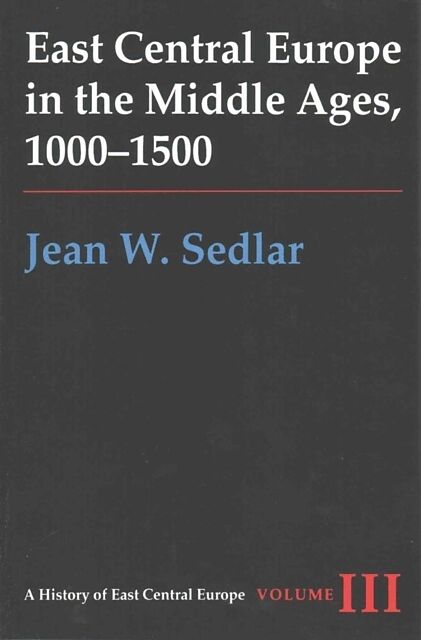East Central Europe in the Middle Ages, 1000-1500
Einband:
Kartonierter Einband
EAN:
9780295972916
Untertitel:
Vol. III
Genre:
Geschichte
Autor:
Jean W Sedlar
Herausgeber:
University of Washington Press
Anzahl Seiten:
569
Erscheinungsdatum:
01.03.2013
ISBN:
978-0-295-97291-6
Informationen zum Autor Jean W. Sedlar Klappentext Although the Middle Ages saw brilliant achievements in the diverse nations of East Central Europe, this period has been almost totally neglected in Western historical scholarship. East Central Europe in the Middle Ages provides a much-needed overview of the history of the region from the time when the present nationalities established their state structures and adopted Christianity up to the Ottoman conquest. Jean Sedlar's excellent synthesis clarifies what was going on in Europe between the Elbe and the Ukraine during the Middle Ages, making available for the first time in a single volume information necessary to a fuller understanding of the early history of present-day Poland, the Czech Republic, Slovakia, Hungary, Romania, Bulgaria, Albania, and the former Yugoslavia. Sedlar writes clearly and fluently, drawing upon publications in numerous languages to craft a masterful study that is accessible and valuable to the general reader and the expert alike. The book is organized thematically; within this framework Sedlar has sought to integrate nationalities and to draw comparisons. Topics covered include early migrations, state formation, monarchies, classes (nobles, landholders, peasants, herders, serfs, and slaves), towns, religion, war, governments, laws and justice, commerce and money, foreign affairs, ethnicity and nationalism, languages and literature, and education and literacy. After the Middle Ages these nations were subsumed by the Ottoman, Habsburg, Russian, and Prussian-German empires. This loss of independence means that their history prior to foreign conquest has acquired exceptional importance in today's national consciousness, and the medieval period remains a major point of reference and a source of national pride and ethnic identity. This book is a substantial and timely contribution to our knowledge of the history of East Central Europe. Inhaltsverzeichnis Maps Foreword Preface Note on Pronunciation 1) Early Migrations 2) State Formation 3) Monarchies 4) Nobles and Landholders 5) Peasants, Herders, Serfs, and Slaves 6) Towns and Townspeople 7) Religion and the Churches 8) The Art and Practice of War 9) Governments 10) Laws and Justice 11) Commerce and Money 12) Foreign Affairs 13) Ethnicity and Nationalism 14) Languages and Literatures 15) Education and Literacy Appendix 1, Chronology Appendix 2, List of Monarchs Appendix 3, Place Name Equivalents for Towns and Cities Bibliographical Essay Index ...
Autorentext
Jean W. Sedlar
Klappentext
Although the Middle Ages saw brilliant achievements in the diverse nations of East Central Europe, this period has been almost totally neglected in Western historical scholarship. East Central Europe in the Middle Ages provides a much-needed overview of the history of the region from the time when the present nationalities established their state structures and adopted Christianity up to the Ottoman conquest. Jean Sedlar's excellent synthesis clarifies what was going on in Europe between the Elbe and the Ukraine during the Middle Ages, making available for the first time in a single volume information necessary to a fuller understanding of the early history of present-day Poland, the Czech Republic, Slovakia, Hungary, Romania, Bulgaria, Albania, and the former Yugoslavia.
Sedlar writes clearly and fluently, drawing upon publications in numerous languages to craft a masterful study that is accessible and valuable to the general reader and the expert alike. The book is organized thematically; within this framework Sedlar has sought to integrate nationalities and to draw comparisons. Topics covered include early migrations, state formation, monarchies, classes (nobles, landholders, peasants, herders, serfs, and slaves), towns, religion, war, governments, laws and justice, commerce and money, foreign affairs, ethnicity and nationalism, languages and literature, and education and literacy.
After the Middle Ages these nations were subsumed by the Ottoman, Habsburg, Russian, and Prussian-German empires. This loss of independence means that their history prior to foreign conquest has acquired exceptional importance in today's national consciousness, and the medieval period remains a major point of reference and a source of national pride and ethnic identity. This book is a substantial and timely contribution to our knowledge of the history of East Central Europe.
Inhalt
Maps
Foreword
Preface
Note on Pronunciation
1) Early Migrations
2) State Formation
3) Monarchies
4) Nobles and Landholders
5) Peasants, Herders, Serfs, and Slaves
6) Towns and Townspeople
7) Religion and the Churches
8) The Art and Practice of War
9) Governments
10) Laws and Justice
11) Commerce and Money
12) Foreign Affairs
13) Ethnicity and Nationalism
14) Languages and Literatures
15) Education and Literacy
Appendix 1, Chronology
Appendix 2, List of Monarchs
Appendix 3, Place Name Equivalents for Towns and Cities
Bibliographical Essay
Index

Leider konnten wir für diesen Artikel keine Preise ermitteln ...
billigbuch.ch sucht jetzt für Sie die besten Angebote ...
Die aktuellen Verkaufspreise von 6 Onlineshops werden in Realtime abgefragt.
Sie können das gewünschte Produkt anschliessend direkt beim Anbieter Ihrer Wahl bestellen.
Loading...
Die aktuellen Verkaufspreise von 6 Onlineshops werden in Realtime abgefragt.
Sie können das gewünschte Produkt anschliessend direkt beim Anbieter Ihrer Wahl bestellen.
| # | Onlineshop | Preis CHF | Versand CHF | Total CHF | ||
|---|---|---|---|---|---|---|
| 1 | Seller | 0.00 | 0.00 | 0.00 |
